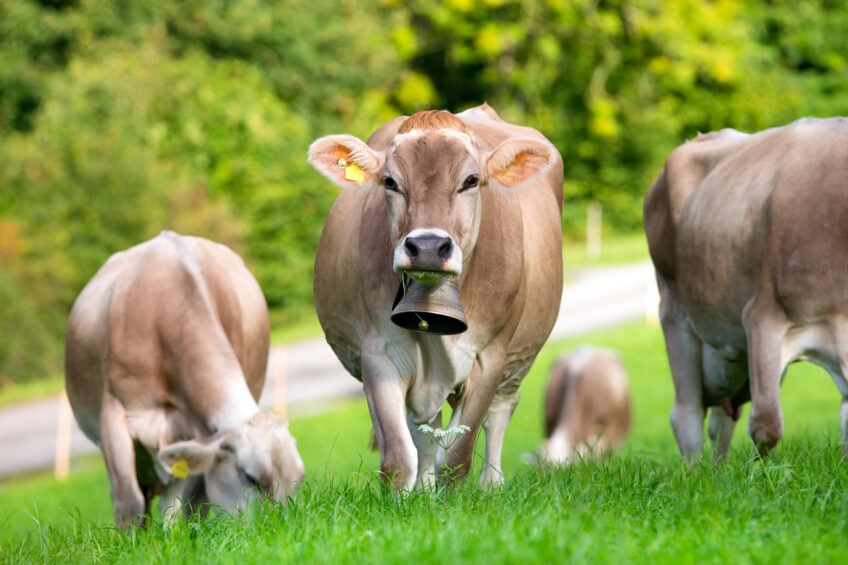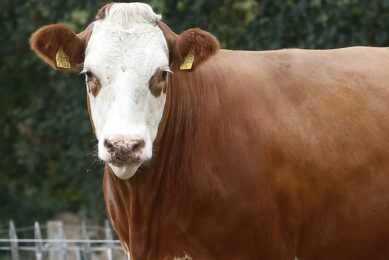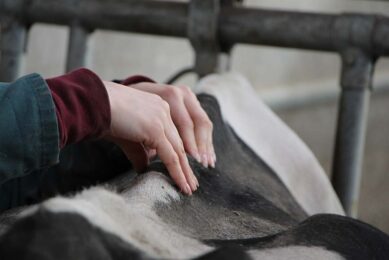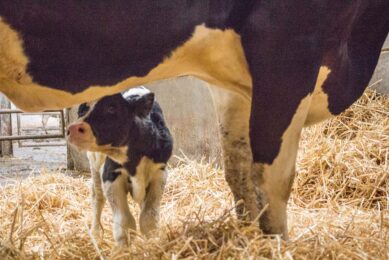Effects of noise on cattle performance

Seldom have the production and behavioral responses of cattle to noise been taken into account. What are the effects, and how can these be prevented?
Husbandry procedures cause the loudest sounds, especially if the metallic equipment is involved or if the work is performed in a hurried manner. The sources of noise can be technical devices, routine works (opening and closing doors, changing pens, washers, push carts, workers’ speech, feed dispensing), basal sound levels caused by mechanical ventilation and animals activities (climbing and chewing on fences). Aircraft overflights are also major sources of noise and can affect feed intake, growth, or production rates in cattle and other domestic animals. The severity of response to disturbance may, however, vary with species, group size, social groups, sex, age, vegetation cover, season, and distance from the aircraft.

Effect of cow bells
The exposure of farm animals to noise has been identified as a potential stressor not only in housing but also during the transport and at the abattoir. Animals are often exposed to acute noise levels before slaughter in lairages where noise is caused by ventilation fans and operational equipment.
In some parts of the world, grazing cows are often equipped with a bell for several months, to ensure that farmers can locate their animals on the wide pastures. In this case, animals tend to decrease head movements to avoid generation of the sound. As a result, the feeding and ruminating durations are decreased because both behaviours include head movements. The reduction of feeding times inevitably leads to reduced utilisation of pasture plants and lower growth rates of young animals. Also, the reduction in rumination time might result in a reduction of saliva production and eventually challenge health through an increased risk of rumen acidosis. Wearing a bell may further lead to a change in vagosympathetic balance, which is used as an animal welfare indicator allowing comparison of different management procedures.
Read also: Cow bells and their effect on cow behaviour
Measurement and acceptable levels of noise
The noise intensity associated with any of the above-mentioned sources is best measured in decibels (dB) using a sonometer. It can also be measured using various mathematical equations using capacity (in kilowatts, kW), power efficiency, and other electromechanical properties of the device or equipment. This latter method is not generally used for farm applications, particularly when noise is generated by external sources of unknown technical properties. Cattle may tolerate moderate levels of noise and may easily adapt to an intensity level of 60-90 dB. Above this level, however, the animals are severely affected to a various extent depending on the factors mentioned above. Under the same condition, the effects of noise on various production parameters of cattle may also vary depending on whether the animals are exposed to noise on continuous or on an intermittent basis. In the latter case, animals are more severely affected as they do not have the chance to adapt to the noise.
Noise and feed intake
Frequent exposure to noise may affect the secretory activity of the adrenal cortex. In this way, the animal may have little motivation to eat due to the resulting slower passage of digested feed, distension of the foregut, and the delayed entry of digested feed into the small intestines, thereby contributing to a lower-than-expected rate of body weight gain. Behaviour changes may also contribute to the reduced feed intake. As indicated earlier, grazing cows equipped with bells tend to decrease head movements to avoid generation of the sound, thereby reducing the amount of pasture plants consumed.
Noise and metabolic processes
Free radicals such as malondialdehyde (MDA), superoxide dismutase (SOD), and glutathione peroxidase (G-Px) are produced during normal metabolism. Under excessive noise, however, the levels of these free radicals may increase to the point where the enzyme antioxidative capacity is insufficient to alleviate their effects. The increased level of such products is an indication of the damage to polyunsaturated fatty acids, which initiate the lipid peroxidation reactions to other metabolic changes that might be toxic to cellular components.
Effects of noise on the endocrine system
Under conditions of noise stress, the adrenal gland will produce smaller amounts of cyclic adenosine monophosphate (cAMP), which is believed to moderate some harmful responses. It has also been reported that production of glucocorticoids is elevated by excessive noise. This should give rise to a rapid breakdown of glycogen in the muscle cells, leading to a decline in pH and a delay in the temperature drop after slaughter, both of these factors are responsible for pale, soft, exudative (PSE) meat. Further, reproductive hormones, such as estrogen and progesterone, have been found to respond adversely to noise generated by low-flying aircraft.
Tips on reducing noise levels
|
Noise and reproduction
Like water stress and heat stress, chronic noise stress (100 dB or above) also affects the male sex hormone and produces changes in the reproductive organs and glands. Noise stress provokes an increase in serum corticosteroid, which causes up to 80% decline in testosterone concentration. Low testosterone production adversely affects the quality of ejaculates and subsequent fertility. The decrease in testosterone level is also associated with the marked reduction in epididymis sperm number. Moreover, the epididymis sperms are agglutinated upon exposure to noise and the number of dead sperms also increases. Such changes are in most cases irreversible and noise-induced infertility may thus last for the entire reproductive cycle of the male animals. The effects of noise on the reproductive functions of females have not yet been established, but a great deal of work has been done in this area on laboratory animals. The ovaries and the uterus diminished significantly in female rats after a noise exposure of 110 dB for five minutes 15 times per day for 11 days at 375-500 Hz. Remaining oestrus occurs after noise exposure as well. Increase in abortion frequency and foetus resorption, or reduction of foetus weight have been also registered. The uterine blood flow, gas-interchange, nutrition and interchange of waste products between foetus and mother are decreased. The reproductive function of rats can also be affected by when exposed to noise stress. Studies have shown that exposure of rats to the noise of 50-80 kHz at 80-90 dB in the four days during the mating period reduced fertility by 73.2 %. Exposure to 100 dB of 3-12 kHz for one minute during the four days of copulation reduced fertility by 70-80 %. Further research is, however, needed to determine whether such effects may be observed with cows kept in noisy environments.

Noise and milk production
In one study, dairy cows were exposed to sudden noise induced by exploding paper bags every 10 seconds for 2 minutes just prior to attaching the milking machine. This has resulted in an immediate cessation of milk production, probably due to the increased adrenaline level and the change of other neuroendocrine profiles following exposure to sudden noise. When the same animals were exposed to a sudden high-intensity noise (110 dB), such as low altitude jet aircraft overflights at milking time, the effectiveness of the milk ejection reflex was reduced, and decreased efficiency of milk removal and increased residual milk were also observed with an overall reduction in milk yield. However, with frequent exposure to high-intensity noise, the response may not be as negative. In support of this view, milk yield of dairy cows in an area of frequent sonic booms (4-5 times per day) was similar to the yield of control dairy cows. With high-intensity noise, the somatic cell count (SCC) increases, indicating a damage to milk-producing tissue in the udder caused either by toxins or loss of epithelial cells. The increased cell count is also an indicator of the keeping ability of milk, its taste, and how well it can be made into other dairy products such as yogurt or cheese. In extreme cases, i.e. milk with an SCC of more than 400,000 the milk is considered as being unfit for human consumption by the European Union.
Noise and immunity
Animals born to mothers in kept in the noisy environment had smaller thymus weights shortly after birth, as well as lower serum IgG levels, indicating impairment of the secondary immune response. Prenatally stressed animals displayed significant decreases in their humoral immune responses (decreased numbers of T cells and decreases in phagocytic activity). These effects appeared to be mediated by sex, with females generally more impaired than males. Heterophil-to-lymphocyte ratio (H:L) also increased under high-noise condition due to the increased release of corticosterone. Animals with high H:L ratios have been subject to a variety of diseases including liver damage. The noise-immunity relationship has been well established in laboratory animals, and –again-further investigations are still needed to determine whether such relationship exists in cattle and in other domestic animals.
Noise and animal behaviour
The following are some behavioural responses observed under high-noise conditions and should thus be taken as indicators of stress promoting adaptive management practices to ensure proper protection and better performance:
- Animals may jump when exposed to sudden very loud noise (139-143 dB), reduce activity and remain huddled together for up to 30 minutes afterward.
- Animals may freeze into a motionless stance, but may afterward become aggressive.
- Animals may increase defecation and reduce both social activities and non-social activities (sniffing, grooming or crawling).
- When the aircraft was 152 m above ground level, the cattle ran for less than 10 meters and resumed normal activity within one minute. Unexpected high-intensity noise, such as low altitude jet aircraft overflights (above 110 dB), at milking parlor, could provoke the adverse behaviour, such as kicking or stomping. The noise threshold expected to cause a behavioural response by cattle is 85 to 90 dB. Noises greater than threshold have provoked retreat, freezing, or strong startle response.
- Heifers exposed to the noise from milking parlour show escape-type behaviours, consistent with a fear response.
- Animals respond to helicopter flights by decreasing their time spent foraging and they were the most sensitive to disturbance during winter (43 % reduction in foraging efficiency).
- Grazing animals are often disoriented and run away in response to helicopter over-flights. However, it was found that helicopter flights did not cause mothers to abandon their young, nor adversely affect their immediate or long-term welfare.
- Observations noted that animals galloped in response to jet flyovers. Intensive flight reactions, random movements, and biting/kicking behaviour were also displayed.
References are available from the author upon request .
Join 13,000+ subscribers
Subscribe to our newsletter to stay updated about all the need-to-know content in the dairy sector, two times a week.










